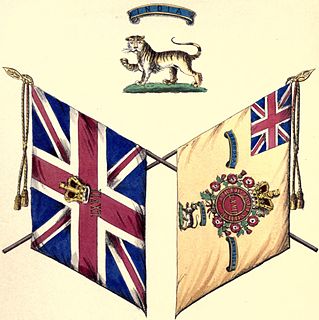
Field Marshal Studholme Hodgson was a British Army officer who served during the 18th century. After serving as an Aide-de-Camp to the Duke of Cumberland at the Battle of Fontenoy during the War of the Austrian Succession and at the Battle of Culloden during the Jacobite Rebellion, he became correspondent to William Barrington, the Secretary at War, during the French and Indian War. He went on to command the British expedition which captured Belle Île in June 1761 during the Seven Years' War so enabling the British Government to use the island as a bargaining piece during the negotiations leading up to the Treaty of Paris in 1763.
Ralph Burton was a British soldier and Canadian settler.

Henry Vane, 2nd Earl of Darlington was a British peer.
The 89th Regiment of Foot was a regiment of the British Army, raised on 3 December 1793. Under the Childers Reforms the regiment amalgamated with the 87th Regiment of Foot to form the Princess Victoria's in 1881.

General Lord George Henry Lennox was a British Army officer and politician who sat in the House of Commons from 1761 to 1790.
The 78th Regiment, (Highland) Regiment of Foot also known as the 78th Fraser Highlanders was a British infantry regiment of the line raised in Scotland in 1757, to fight in the Seven Years' War. The 78th Regiment was one of the first three Highland Regiments to fight in North America.
General John Waldegrave, 3rd Earl Waldegrave was a British politician and soldier.

The 55th Regiment of Foot was a British Army infantry regiment, raised in 1755. After 1782 it had a county designation added, becoming known as the 55th (Westmorland) Regiment of Foot. Under the Childers Reforms it amalgamated with the 34th (Cumberland) Regiment of Foot to form the Border Regiment in 1881.
The 38th Regiment of Foot was an infantry regiment of the British Army, raised in 1705. Under the Childers Reforms it amalgamated with the 80th Regiment of Foot to form the South Staffordshire Regiment in 1881.
General Lord Robert Manners was an English soldier and nobleman. He was a son of John Manners, 2nd Duke of Rutland and his second wife, Lucy Sherard.

The 67th Regiment of Foot was a line infantry regiment of the British Army, raised in 1756. Under the Childers Reforms it amalgamated with the 37th Regiment of Foot to form the Hampshire Regiment in 1881.
The 61st Regiment of Foot was an infantry regiment of the British Army, raised in 1756. Under the Childers Reforms it amalgamated with the 28th Regiment of Foot to form the Gloucestershire Regiment in 1881.
The 87th Regiment of Foot was a Scottish infantry regiment in the British Army, formed in 1759 and disbanded in 1763.
The 80th Regiment of Light-Armed Foot was the first light infantry regiment in the British Army.
The 103rd Regiment of Foot was a British Army regiment formed at Bury St Edmunds in October 1760. It took part, alongside the Royal Marines, in the Capture of Belle Île in April 1761 during the Seven Years' War. It was then disbanded in England in 1763.
The 76th Regiment of Foot was a regiment of the British Army from 1756 to 1763.
The 71st Regiment of Foot was a regiment in the British Army from 1758 to 1763.
John Craufurd was a British Army officer and politician who sat in the House of Commons between 1761 and 1764.
The 90th Regiment of Foot was a short-lived infantry regiment in the British Army which was raised in Ireland as a light infantry corps in 1759, during the Seven Years' War with France.
The 85th Regiment of Foot was a short-lived British Army regiment during the Seven Years' War. It was recruited at Shrewsbury in 1759 as the first full regiment of light infantry in the British Army and originally intended for service in the North American campaign.




